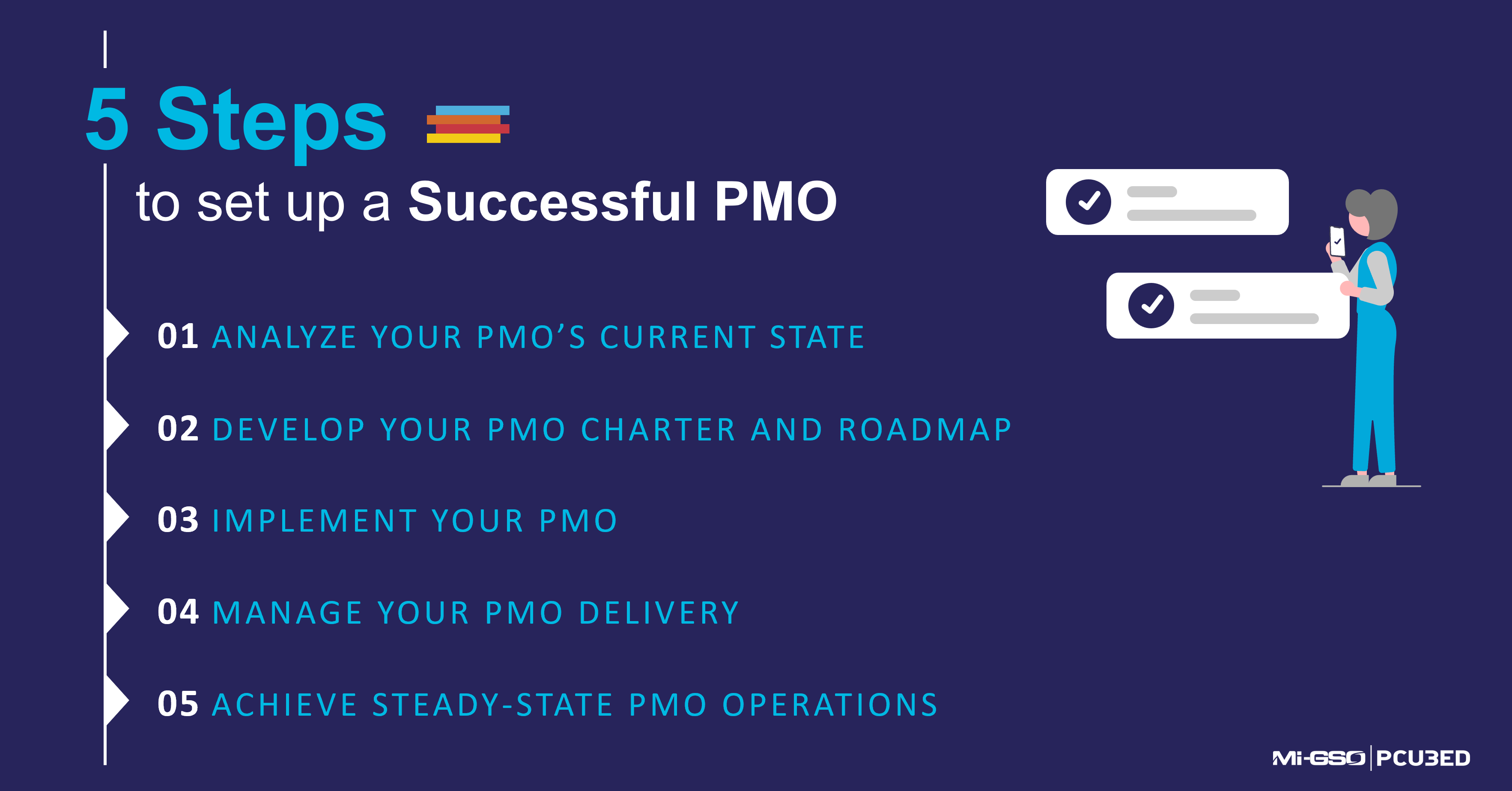PMO Setup: Your How To Guide
No matter how effective your project and program management efforts are, they can always be improved upon. When something isn’t going right in a project — progress is delayed, there’s a lack of visibility into project status, scope is out of control — a project or program management office (PMO) could be just the antidote!
Table of Contents
Because the success of projects primarily revolves around the activities of human beings, to succeed in a project, all stakeholders must be involved and committed to reaching the same goals as the project itself.
It may be that the people involved in the project aren’t familiar with the proven disciplines of project management for addressing risk, quality, scheduling and so on. Or, it could be that borrowing best practices from other industries could enhance existing practices.
Finally, it just might be that the people working so hard on the project are better off staying focused on their core areas of expertise – leaving project management to those who are trained in that skill set, i.e. your PMO.
Yet, if you don’t have a PMO or access to a PMO, setting up an organizational PMO to address those needs is a project in itself. MIGSO-PCUBED is often called in to provide PMO Setup & Delivery consulting services, implementing enhancements in organizational and team capability, either as a new center of excellence or through redefining the operation and capability of an existing organization or team.
An approach to PMO Setup and Delivery
The implementation and operation of a Program Management Office (PMO) can provide an organization with the capability to provide visibility and insight into critical business programs and to enable effective decision-making and control.
We have found that in the beginning stages of PMO setup, clients don’t always understand why they would need a PMO. When they finally work with a great PMO, however, they’re sold. The best PMOs bring outside views, think out of the box, provide expertise in project and program methodology and become a real partner to the organization.
Here are the five core steps we recommend in setting up a PMO:
Setting up a successful PMO: 5 Key Steps

1. Analyze your PMO’s Current State
Step 1 is to analyze the “As-is” situation. As painful as self-analysis can be, the problems infecting the projects have to be identified and the potential solutions defined first. This process calls for analysis of the current project team structure, organization and ways of working, as well as the interfaces that exist – interactions to other departments, suppliers and clients. The results of the analysis form the content of the business case for setting up the PMO.
Our advice: Do the analysis quickly and look for feedback and support from those in the business function that are suffering from the fallout of the problems.
2. Develop your PMO Charter and Roadmap
Step 2 is to define the PMO Charter and Roadmap. The charter spells out what the PMO is expected to accomplish and how success will be measured. The PMO Roadmap provides a clear view on early wins and long term gains for the organization.
It’s very important in establishing the PMO Roadmap, to define a path that best fits the organization’s values, capacity and ability to implement controls. This should cover the overall governance, people, process and tools. Because project managers will need to “buy” into the proposed changes, ensure that you socialize the proposal with key stakeholders to obtain feedback.
Finally all members of the PMO are able to clearly articulate the benefits or “what’s in it for them” to “sell” the PMO structure to those who would oppose or resist it.
Our advice: Don't get too ambitious. Be conservative in your promises. Go for low-hanging fruit where you know the work of a PMO can have a quick and satisfying outcome.
3. Implement your PMO
Step 3 – it’s time to put the PMO structure in place. This is the stage where you’ll deploy the people, processes, and tools to achieve your short-term PMO objectives.
Read our case study: Advanced PMO Setup for an Automotive client
The PMO will also begin the work of filling in the details of the governance model (and possibly a governance council) as you work to attain initial control of programs and projects.

Finally, it is important to stay in touch with stakeholders to understand their challenges and current priorities. The PMO Roadmap is not set in stone. As such, you will need to regularly review progress status against the goals set for the PMO and adjust to reflect the latest needs from your community.
Our advice: As you get a win, share it; as you get a loss, acknowledge that. Adjust the work as needed and keep moving forward.
4. Manage your PMO Delivery
Step 4 is to manage the evolution of the PMO towards the long term gains, working towards steady state operation. The focus here is to formalize those activities that are having a major impact on project outcomes.
For example, say that pockets of people are finally entering timely updates into the enterprise project system regarding tasks, resources, budget because the PMO focused on user experience and made the form easier to use. If that results in improvements in project reporting and better management decision-making, it’s worth embedding the practice of updating project details into required job duties. Even though this adoption of new processes and work habits becomes a change management challenge, remember that success begets enthusiasm.
Our advice: Be prepared for backsliding and stay patient. Change isn't easy -- even for project managers.
5. Achieve Steady-State PMO Operations
Step 5 is steady state operations driving continuing evolution towards your desired PMO maturity level. Regular reviews will quickly tell you whether your PMO is finding success in its current objectives. Is that good enough? Perhaps.
Once the PMO has earned credibility with the business it usually receives requests to help manage business projects. So you should start seeing the scope of initiatives undertaken by the PMO to broaden from functional projects to enterprise-wide work. If that is not the case, you may find that you need to seek outside help to achieve a step-level improvement.
We at MIGSO-PCUBED understand the challenging nature of organizational program and project management. We have a proven track record helping our clients deliver their most critical and complex programs, alongside enabling successful PMO and PMO as a Service implementations within the context of any organization.
Our advice: Choose a PMO consultancy with a track record in helping clients deliver critical and complex programs, including the set-up of a PMO.
Laurence Falgarona contributed to this article originally published on pcubed.com and distributed by Frost & Sullivan.
You might also like:
Loved what you just read?
Let's stay in touch.
No spam, only great things to read in our newsletter.





